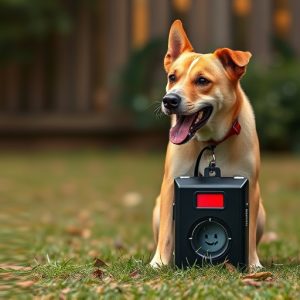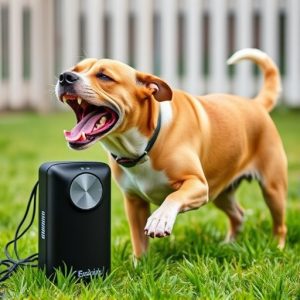Maximizing Effectiveness: Unlocking the Power of Electronic Dog Repellers
Electronic dog deterrents use ultrasonic waves in the 20-60 kHz range, audible only to dogs, to keep…….
Electronic dog deterrents use ultrasonic waves in the 20-60 kHz range, audible only to dogs, to keep them away from specific areas. Their effective distance, up to 20 meters (66 feet), varies by model and environmental conditions. These devices are particularly useful for outdoor spaces, gardens, and indoor areas where traditional visual deterrents may not work. To maximize their impact, it's crucial to match the frequency range to a dog's hearing sensitivity and consider factors like obstructions and weather conditions.
“Discover the power of electronic dog deterrents, a humane and effective solution for keeping dogs away from unwanted areas. This article delves into the science behind these devices, exploring the critical concept of frequency ranges and their impact on repellency. We’ll guide you through understanding the factors influencing the effective distance of these tools. By the end, you’ll be equipped to make informed choices, ensuring optimal results in keeping your spaces dog-free while maintaining a peaceful coexistence with our four-legged neighbors.”
- Understanding Dog Repeller Technology: Unveiling the Science Behind Electronic Deterrents
- Defining the Effective Frequency Range: What Waves Can and Can't Do Against Dogs
- Factors Affecting Distance: Maximizing the Impact of Your Electronic Dog Repeller
Understanding Dog Repeller Technology: Unveiling the Science Behind Electronic Deterrents
Dog repellers, also known as electronic deterrents, utilize specific sound frequencies to keep dogs away from certain areas. The technology behind these devices is based on the principle that dogs, with their more sensitive hearing, can detect and be uncomfortable with high-frequency sounds that are inaudible or barely perceptible to humans. These repellers emit ultrasonic waves, typically within a frequency range of 20 kHz to 60 kHz, which are designed to be annoying or even painful for dogs without causing them any harm.
The effective distance of these electronic dog deterrents can vary depending on the model and environmental factors like wind and noise levels. However, many reputable devices offer an impressive effective range of up to 10-20 meters (33-66 feet), ensuring that they can protect larger areas without requiring constant activation or multiple units. This technology is particularly useful for outdoor spaces, gardens, and even indoor environments where traditional visual deterrents might not be as effective in training dogs to stay away.
Defining the Effective Frequency Range: What Waves Can and Can't Do Against Dogs
Defining the effective frequency range is key when considering an electronic dog deterrent. These devices operate using specific sound waves designed to disrupt a dog’s behavior, usually within a certain distance known as the effective distance. The most common frequencies used are inaudible to humans, ranging from 3-40 kHz, which target dogs’ highly sensitive hearing.
While these sounds can effectively startle and deter dogs, they have limitations. Not all dogs react equally to these frequencies, with breeds like Labrador Retrievers and Golden Retrievers proving more resilient. Additionally, external factors such as background noise, weather conditions, and the dog’s temperament can affect the device’s effectiveness. Therefore, understanding the specific frequency range and its capabilities is crucial for choosing the right electronic dog repeller.
Factors Affecting Distance: Maximizing the Impact of Your Electronic Dog Repeller
The effective distance of an electronic dog repeller is influenced by several key factors, allowing users to maximize its impact in different settings. One major consideration is the specific frequency range employed by the device. High-frequency sounds often prove more effective in deterring dogs as they are more sensitive to these ranges. However, for the best results, it’s crucial to match the frequency with the typical hearing abilities of the target dog breed(s). Different breeds have varying sensitivity levels, so tailoring the repeller’s settings accordingly ensures optimal performance.
Another factor is the environmental conditions. Obstructions like walls, trees, or other structures can significantly reduce the device’s range. When using an electronic dog deterrent outdoors, consider these barriers and adjust the placement and settings to maintain line-of-sight access to ensure the most effective distance. Additionally, factors such as wind, temperature, and humidity may also impact sound transmission, so users should be prepared to make adjustments for varying weather conditions.
In conclusion, an effective electronic dog deterrent relies on understanding both the science behind dog repeller technology and the specific frequency range that works best. By optimizing the distance and considering environmental factors, you can maximize the impact of your device. Remember, while these devices offer a humane and non-lethal solution, consistent training and positive reinforcement remain crucial for long-term success in managing canine behavior.


